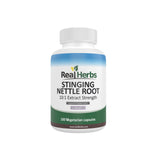Pygeum Bark: A Holistic Approach to Managing BPH Symptoms
Men over 50 are more likely to develop Benign Prostatic Hyperplasia (BPH), which is characterized by the non-cancerous enlargement of the prostate gland. The urethra, the tube that transports urine from the body, is surrounded by the prostate gland, a little organ with a walnut-like form. A number of symptoms, such as difficulty peeing, poor urine flow, frequent urination, and the need to urinate urgently, can be brought on by the pressure that the expanding prostate gland can put on the urethra. The quality of life and daily activities of a man might be significantly impacted by these symptoms.
While there are pharmaceutical choices available to treat BPH symptoms, many men prefer a more natural approach without the negative side effects. Pygeum bark is one such alternative. Pygeum bark is a type of African tree commonly known as Prunus Africana. Traditional healers have been using the tree's bark to cure a number of ailments, including BPH, for ages. Numerous studies on its efficiency in treating BPH symptoms have been conducted since it was originally introduced to Western medicine in the 1960s. Many men find pygeum bark to be an appealing alternative because it is a natural and secure method of treating BPH symptoms.
History
Pygeum bark is a type of African tree commonly known as Prunus Africana. Traditional healers have been using the tree's bark to cure a number of ailments, including BPH, for ages. Numerous studies on its efficiency in treating BPH symptoms have been conducted since it was originally introduced to Western medicine in the 1960s.
How it works
Although the precise process by which Pygeum bark reduces the symptoms of BPH is not fully understood, it is believed to work through a variety of distinct mechanisms.
Phytosterols, one of the essential components in Pygeum bark, have been shown to have anti-inflammatory effects on the prostate. These substances, which resemble cholesterol structurally, have been found to suppress the activity of inflammatory enzymes including cyclooxygenase and lipoxygenase. The symptoms of difficult urination and poor urine flow may improve as a result of the reduction in inflammation, which can also aid in shrinking the prostate and relieving pressure on the urethra.
Ferulic acid, another substance discovered in Pygeum bark, has been shown to have antioxidant capabilities. This substance may be capable of protecting the prostate's cells from the harm that free radicals can do, which can promote the growth of the prostate.
Triterpenes, a class of chemicals with anti-inflammatory and anti-proliferative properties, are also found in pygeum bark. The 5-alpha-reductase enzyme, which is involved in the development of the prostate, has been discovered to be inhibited by these substances. Pygeum bark can assist to lessen the symptoms of BPH and delay prostate enlargement by preventing the activity of this enzyme.
In conclusion, Pygeum bark is thought to be effective by reducing inflammation and swelling in the prostate, protecting cells in the prostate from harm, and decreasing the action of specific enzymes to limit prostate growth.
Studies and Results
Numerous studies have been done to determine how well Pygeum bark treats BPH symptoms. A randomized, double-blind, placebo-controlled study with 112 males is one of the studies that is most frequently cited. According to the study, those who took Pygeum bark had significantly fewer symptoms than those who took a placebo. The International Prostate Symptom Score (IPSS), a validated questionnaire used to assess the severity of symptoms related to BPH, specifically showed improvement in individuals taking Pygeum bark.
Another investigation involving 200 males likewise produced encouraging outcomes for Pygeum bark. According to the study, those who took Pygeum bark had better urine flow and less frequent urination. Pygeum bark was also shown to be well accepted and to have no harmful side effects, according to the study.
In addition to this research, a number of other studies have discovered that Pygeum bark is efficient in treating the symptoms of BPH. Additionally, Pygeum bark has been shown in certain trials to enhance the quality of life for men with BPH by minimizing the negative effects of symptoms on daily activities.
It's important to note that certain studies have produced contradictory findings, and further investigation is required to completely comprehend Pygeum bark's efficacy in treating BPH symptoms. The majority of studies have discovered that Pygeum bark can be a useful substitute for controlling BPH symptoms.
In conclusion, it has been discovered that pygeum bark works well for treating BPH symptoms. According to research, it can enhance urinary flow, lessen frequent urination, and enhance quality of life. It can also improve the International Prostate Symptom Score. It is regarded as safe and has few adverse effects. As usual, it's crucial to speak with a medical expert before beginning a new supplement program.
Recommended Dosage
The recommended dosage of Pygeum bark for the management of BPH symptoms varies depending on the specific product. A typical dosage is between 50 and 100 milligrams per day, taken in the form of a capsule or extract. It is important to consult with a healthcare professional before starting any new supplement regimen.
Conclusion
For men seeking a more integrative method of treating BPH symptoms, pygeum bark is a possible alternative. Studies have shown that it is useful in lowering symptoms including difficulty peeing and weak urine flow, while further research is required to completely understand its mechanism of action. As usual, it's crucial to speak with a medical expert before beginning a new supplement program.
References
"Phytotherapy for benign prostatic hyperplasia: a review of randomized controlled trials." Planta Med. 2003; 69(1): 1–8.
"Efficacy and safety of the extract of Serenoa repens in the treatment of symptomatic benign prostatic hyperplasia: a randomized, double-blind, placebo-controlled trial." BJU Int. 2002; 90(9): 863–867.
"Pygeum africanum in the treatment of patients with benign prostatic hyperplasia: a review of 25 years of published experience." Curr Ther Res. 1993; 53(5): 574–589












